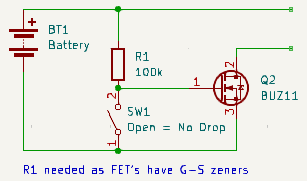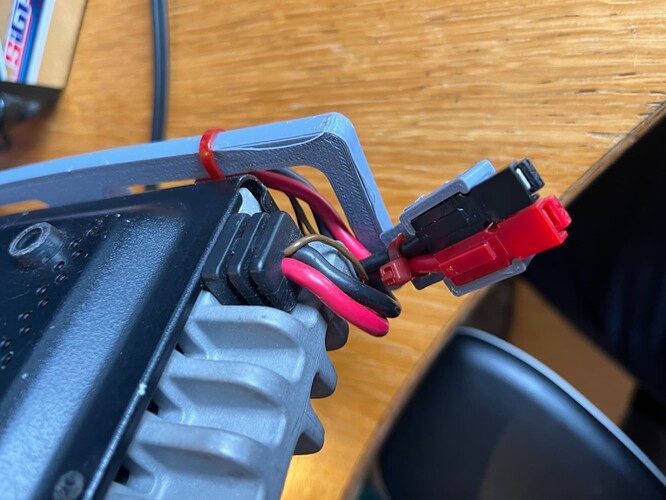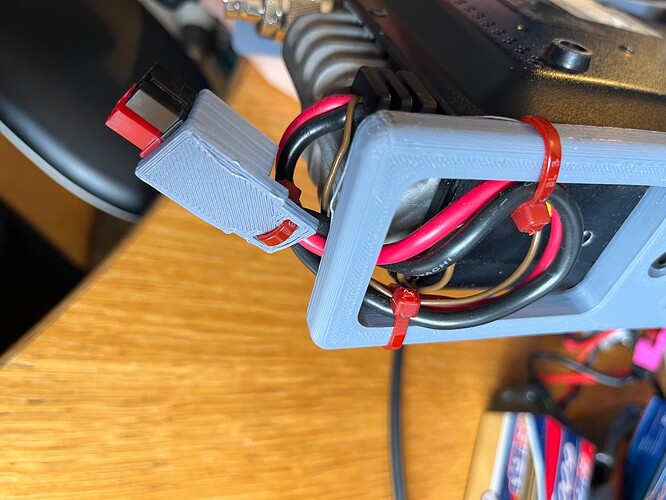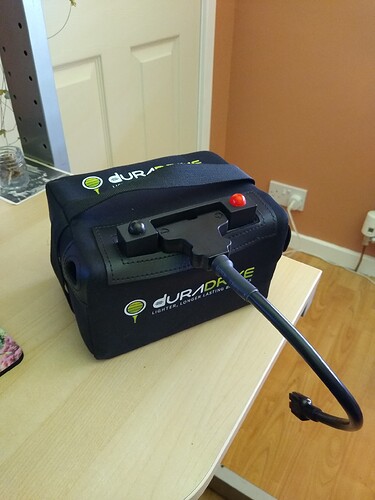Thanks. These are all great responses, but a cheap and cheerful SLAB is my go to at the moment. Looking online, I can find one for £17 so this is probably what I will try to get started.
Lots of good advice already.
I tend not to use my FT857 & FT891 for SOTA. But when I use them I use the following batteries:
I use an UltraMax 22Ah battery when car portable or a v. small distance to a picnic bench/field.
I carry a Zippy 8400mAh when walking a bit further and when I tend to stay out longer, I may carry two.
FT857 RX current draw is advertised as 1A but I found it to be a bit less than that.
How long a battery lasts depends of course on your power level and the RX/TX ratio.
During a pile-up, your RX/TX ratio could be 50/50, whereas during normal operating it could be 75/25.
Approximate FT857 TX current draw:
5W = 5.8A
20W = 7A
50W = 11A
100W = 16A
So operating at 50W 75/25 ratio (RX/TX) should give you a little below 2.5 hrs of operating with a healthy fully charged 8400 mAh battery.
Good luck.
Hi Alex -
You could try the SLAB and run SSB at 10W and likely be okay for short activations. But why carry a 100W radio when all you can run is 10W?
When I ran my FT-857d SSB at 100W with a 45Ah slab it would transmit “FM” - that is, a distorted signal on peaks when the SLAB was pulled below 11.5V. I had much better luck with a 6Ah LiFePO4 battery, keeping output power below 20W for short activations. However, you could be successful and have a lighter pack with an Xiegu X6100 at 10W or a Xiegu G90 at 20W or a FX-4CR at 20W and perhaps a 4.5Ah LiFePO4.
73, Etienne-K7ATN
I will never buy another one, as they always seem to be single use: by the time you take it off the shelf it has self-discharged, and is completely dead. I’d go for LiFePo4 now.
A power fet is a convenient high current diode with a bolt hole, with the advantage that it is also a reverse protection diode even when you turn it on to bypass the diode drop.
N-Fet in the negative wire or P-fet in positive wire.
Switch is only there to turn the diode drop on/off, it does not switch the power. As a low drop diode SW1 is not used.
When you use an N-fet in the negative lead you also protect against the power lead being reversed in a vehicle, and the +ve battery shorting to chassis via the antenna.
This is an ft-817 failure mode that burns out the power filter choke and/or the pcb
Hi Simon,
Like you I’ll never buy a SLAB again. Prices here for a 7 AH one range from AUD$25 - $70. A 10Ah LiFe with BMS can be had today for AUD$80 from a local warehouse.
I suspect the rise in price of SLABs is due to concern the old alarm may malfunction with “new technology” and void the insurance policy. Paying up to $50 extra is an easy solution for companies. But it’s every 2 years ( fine print). And it’s poor economy for an individual. And it’s unnecessary weight for portable use.
I hear one SOTA operator so missed the weight of his SLAB that he now packs an anvil to keep up the weight.
Whatever battery you use enjoy SOTA. The sunspots will fade away soon and propagation will slump. Just get out there now.
73
Ron
VK3AFW
Thanks Alex for asking this question; there has been a lot information supplied in this discussion. Been most enlightening to me from all experiences detailed. Thanks all.
Geoff vk3sq
Yes and I want a pony!
Seriously, there are a variety of 817s on offer on eBay etc. all for more than I sold mine. But there enough at bargain prices coming up that the wise purchaser will watch the market for some weeks/months first before paying out their hard earned cash.
Hi Simon,
Although i haven’t used it much yet, I use 6aH protected Lithium Ion with my 857. I also have 4aH to add to this if i need to operate for longer. And a 2Ah but only really use this for my QRP radio - Xeigu.
One thing I did is cut away all the auto cable and ferrite (not needed for SOTA) and add a power-pole with the cable tied to my 857 rails for strain relief. My batteries are fused. I like this solution, makes its compact.
Cheers
Tim
The best battery is the one you have available…but…
If you go for SLAB, be aware that there are two types.
-
Those designed for eg alarm systems which are typically float charged all the time. They don’t supply a high current and don’t like being charge / discharge cycled. They are relatively cheap.
-
Those designed for eg UPS systems. They will supply high current, and are much more tollerant of repeated charge / discharge. They are relatively expensive. (These are often described as “deep cycle” batteries)
I started SOTA back in 2006 with a 12AH SLAB which lasted for a little over two years running a FT-290R plus a 25W 2m linear initially, then moving over to a FT-817. The 12AH SLAB was heavy, so when it died I purchased several 3.3AH SLABs so I could reduce the physical load when doing multiple summits involving a return to the car after each summit. They lasted even less time.
By 2009 LiPOs were getting cheaper, so I bought four 4AH batteries, three of which are still in use. I used to run these in series with a huge 10AH NiMH cell to power the FT-857 when I bought it. It was like monochrome turning to technicolour… the LiPOs were so much better. When LiFePO4s became cheap enough I moved over to them and haven’t looked back.
Incidentally, I spotted these on eBay - 32700 3.2V 6000mAh to 6100mah LiFePO4 Cell Rechargeable Battery 4 batteries | eBay which might offer an inexpensive solution.
73, Gerald
You get what you pay for.
For many years I used 7Ah SLABs. On average each one lasted me less than a year (albeit that was still around 100 activations!)
I’ve had my Tracer LiFePO4 16Ah pack for over 9 years and used it on over 1000 activations. It’s still going strong. Furthermore, it’s ready to to work out of the box - no need to attach connectors etc.
I’ve definitely got significantly more activating per £ spent on battery from the Tracer pack than I ever did from SLABs.
Probably be a 7Ah for that price. Note that the capacity 7Ah will be quoted at the C/10 or C/20 rate. i.e. if it’s the C/10 rate then you can pull 700mA an hour for 10hours. It doesn’t mean you can draw 7A for 1hour. At high currents the capacity is less than 7Ahr. You will not get much operating time on an 857 with such a battery.
SLABs are obsolete technology. You really want to invest in Lithium batteries both from energy density and low weight. But mainly because most Lithium batteries allow very high current draw which is exactly what you want.
This LiPo (which is not as good tech as LiFePo) is £22 from Amazon. It’s only 5Ah but is infinitely more usable. Amazon.co.uk. By all means buy a SLAB but it’s not the best bang per buck by a long way.
Rather tasty especially as we now have a battery welder in my club. 4 cells and a LiFePO BMS comes to £32. Plus some welding strip, wire and heatshrink and that’s an attractively priced pack.
The real capacity of a SLAB is actually only about 50% of the rated capacity at discharge rates likely with amateur radio equipment. I always find it amusing when people ask for advice, get an overwhelming consensus, and simply ignore it.
I bought two of these 7 AH LIFePO about 10 years ago when I had the strength to carry an FT-857 up the hills. They are still working well, no leaks, no swelling and both chargers that I got with them still function. When this firm sold them on the old days they were just sold as Generic “Ultramax” 7 AH Lithium batteries. Nowadays with all the lawn mowers, etc they are naming them to suit the specific device.
I really rate these batteries highly… you need at least 7 AH to run the FT-857 at 50 watts + for any length of time.
73 Phil G4OBK
I would second Phil’s words on these batteries. I have owned one of the 7 Ah versions for several years, and have no complaints. It has survived being exposed to some less than ideal conditions, including a damp overnight stay on GW/SW-008! ![]()
Thanks for the input everyone.
I eventually went for a lifepo4 golf buggy battery.
Not the lightest, but that’s ok, I’m a keen walker, and also not flush with cash, so used to yomping up hills with the cheaper, but heavier gear. This should give me hours of operation. Looking forward to my first activation! ![]()
Ecky thump! £470, I have the same and still working perfectly. Did you sell them separately? I’m tempted to sell mine. But it would leave me without 6m and 2m SSB/CW.
Yes. All filters pulled out then 2 radios sold privately for cash and the original 817 and filter sold separately on eBay when they had an 80% off fees weekend. Selling all that paid for my KX2. Two more CW filters to sell and by then I’ll have replaced some ageing but nice radios for modern SDR stuff, a KX2 and an IC-705 for the modest outlay of £525-575. The money spent on the 3 old radios long since written off through the pleasure they provided.
Yes, a 21yo bit of kit still working as new “owns me nothing”. (as my mate is fond of saying). It’s only laziness and sentimentality that’s stopping me getting off my backside. And the cash yielded would lessen my guilt when splashing out for something new.



